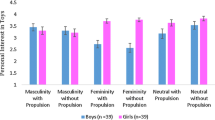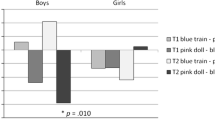Abstract
Sex differences in play behavior across the early elementary school years as well as the relation between sex-typed play and peer acceptance were examined. It was hypothesized that children who were more sex-typed in their play behaviors would be more accepted by their peers. The participants included 86 grade two children and 81 grade four children. Popularity was assessed using a rating scale sociometric measure. Sex-typed behaviors were measured by observing the children at free play. Results indicated significant age and gender differences in children's play behavior. Specifically, boys engaged in more aggressive and rough and tumble play as well as more functional, solitary-dramatic and exploratory play and tended to be involved more in group play, whereas girls produced more parallel and constructive play as well as more peer conversations. In grade 4, these differences were maximized such that boys produced more games-with-rules and girls exhibited more parallel-constructive activity. Second, results indicated that sociometric ratings and observed degree of sex-typing were not significantly related except in the case of fourth grade males. At the fourth grade level, a positive relation was observed between boys' acceptance by male peers and “masculine” or male-preferred play behavior as well as between boys' acceptance by female peers and “feminine” or female-preferred play.
Similar content being viewed by others
References
Appelbaum, M. I., & McCall, R. B. (1983). Design and analysis in developmental psychology. In W. Kessen (Eds.), Handbook of child psychology, (Vol. 1): History, theory & methods. New York: Wiley.
Asher, S. R., Singleton, L. C., & Taylor, A. (1983). Acceptance versus friendship: a longitudinal study of racial integration. Paper presented at the annual meeting of the American Educational Research Association, New York.
Asher, S. R., Singleton, L. C., Tinsley, B. R., & Hymel, S. (1979). A reliable sociometric measure for preschool children. Developmental Psychology, 15, 443–444.
Berndt, T. J. & Heller, K. A. (1986). Gender stereotypes and social influences: A developmental study. Journal of Personality and Social Psychology, 50, 889–898.
Bussey, K., & Perry, D. G. (1982). Same-sex imitation: The avoidance of cross-sex models or the acceptance of same-sex models? Sex Roles, 8, 773–784.
Campbell, P. B. (1980). Student interaction: The importance of race and sex. Paper presented at the Annual Meeting of the American Educational Research Association, Boston, Massachusetts.
Connor, J. M. & Serbin, L. A. (1977). Behaviorally-based masculine-and feminine-activity-preference scales for preschoolers: Correlates with other classroom behaviors and cognitive tests. Child Development, 48, 1411–1416.
DiPietro, J. A. (1981). Rough and tumble play: A function of gender. Developmental Psychology, 17, 50–58.
Eder, D. & Hallinan, M. (1978). Sex differences in children's friendships. American Sociological Review, 43, 237–250.
Eisenberg, N., Tryon, K., & Cameron, E. (1984). The relation of preschoolers' peer interaction to their sex-typed toy choices. Child Development, 55, 1044–1050.
Eron, L. D., Huesmann, R., Brice, P., Fischer, P., & Mermelstein, R. (1983). Age trends in the development of aggression, sex-typing, and related television habits. Developmental Psychology, 19, 71–77.
Fagot, B. I. (1981). Continuity and change in play styles as a function of sex of child. International Journal of Behavioral Development, 4, 37–43.
Fagot, B. I. (1984). Teacher and peer reactions to boys' and girls' play styles. Sex Roles, 11, 691–702.
Fagot, B. I., & Leinbach, M. D. (1983). Play styles in early childhood: Social consequences for boys and girls. In M. Liss (Ed.), Social and cognitive skills: Sex roles and children's play. New York: Academic Press.
Fagot, B. I., & Patterson, G. R. (1969). An In Vivo analysis of reinforcing contingencies for sex-role behaviors in the preschool child. Developmental Psychology, 1, 563–568.
Fling, S., & Manosevitz, M. (1972). Sex-typing in nursery school children's play interests. Developmental Psychology, 1, 563–568.
Green, R. (1977). Atypical sexual identity: The “feminine” boy and the “masculine” girl. In E. K. Oremland & J. D. Oremland (Eds.), The sexual and gender development of the young children: The role of the educator. Cambridge, Mass.: Ballinger Publishing Co.
Groos, K. (1898). The play of animals. New York: D. Appleton.
Hayden-Thomson, L., Rubin, K. H., & Hymel, S. (1987). Sex preferences in sociometric choices, Developmental Psychology, 23, 558–562.
Humphreys, A. P., & Smith, P. K. (1987). Rough and tumble, friendship, and dominance in school children: Evidence for continuity and change with age. Child Development, 58, 201–212.
Huston, A. C. (1983). Sex-typing. In E. M. Hetherington (Ed.), Handbook of child psychology. (Vol. 4): Socialization, personality & social development, (pp. 387–467). New York: Wiley.
Huston, A. C., & Carpenter, C. J. (1985). Gender differences in preschool classrooms: The effects of sextyped activity choices. In L. C. Wilkinson & C. B. Marett (Eds.), Gender-related differences in the classroom. New York: Academic Press.
Krantz, M. (1982). Sociometric awareness, social participation, and perceived popularity in preschool children. Child Development, 53, 376–379.
Ladd, G. W. (1983). Social networks of popular, average, and rejected children in school settings. Merrill-Palmer Quarterly, 29, 283–307.
LaFreniere, P., Strayer, F. F., & Gauthier, R. (1984). The emergence of same-sex affiliative preferences among preschool peers: A developmental/ethological perspective. Child Development, 55, 1958–1965.
Lyons, J., Serbin, L. A., & Marchessault, K. (1988). The social behavior of peer identified aggressive, withdrawn, and aggressive/withdrawn children. Journal of Abnormal Child Psychology, 16, 539–552.
Maccoby, E. E., & Jacklin, C. N. (1974). The psychology of sex differences. Stanford: Stanford University Press.
Maccoby, E. E., & Jacklin, C. N. (1987). Gender segregation in childhood. In H. Reese (Ed.), Advances in Child Development and Behavior, Vol. 20. NY: Academic Press.
Moore, S., & Updegraff, R. (1964). Sociometric status of preschool children as related to age, sex, nurturance-giving, and dependence. Child Development, 35, 519–524.
Parten, M. (1932). Social play among preschool children. Journal of Abnormal and Social Psychology, 28, 136–147.
Piaget, J. (1962). Play, dreams and imitation in childhood. New York: W. W. Norton & Co.
Rekers, G. (1981). Psychosexual and gender problems. In E. J. Mash & L. G. Terdal (Eds.), Behavioral assessment of childhood disorders. New York: Guilford Press, pp. 483–526.
Richardson, J. G., & Simpson, C. H. (1982). Children, gender, and social structure: An analysis of the contents of letters to Santa Claus. Child Development, 53, 429–436.
Rubin, K. H. (1985). Socially withdrawn children: An “at risk” population? In B. H. Schneider, K. H. Rubin, & J. E. Ledingham (Eds.), Children's peers relationships: Issues in assessment and intervention. New York: Springer-Verlag.
Rubin, K. H., & Clark, M. L. (1983). Preschool teachers' ratings of behavioral problems: observational, sociometric, and social-cognitive correlates. Journal of Abnormal Child Psychology, 11, 273–285.
Rubin, K. H., Fein, G., & Vandenberg, B. (1983). Play. In E. M. Hetherington (Ed.), Handbook of child psychology. (Vol. 4): Socialization, personality & social development, (pp. 693–734). New York: Wiley.
Rubin, K. H., Maioni, T. L., & Hornung, M. (1976). Freeplay behavior in middle- and lower-class preschoolers: Parten & Piaget revisited. Child Development, 47, 414–419.
Rubin, K. H., & Mills, R., (1988). The many faces of social isolation in childhood. Journal of Consulting & Clinical Psychology, 56, 916–924.
Singleton, L. C., & Asher, S. R. (1977). Peer preferences and social interaction among third grade children in an integrated school district. Journal of Educational Psychology, 69, 330–336.
Smilansky, S. (1968). The effects of sociometric play on disadvantaged children: Preschool children. New York: Wiley.
Spencer, H. (1873). Principles of Psychology, Vol. 2 (3rd ed.). New York: Appleton.
Stericker, A. B., & Kurdek, L. A. (1982). Dimensions and correlates of third through eighth graders' sex-role self-concepts. Sex Roles, 8, 915–929.
Sutton-Smith, B. (1979). Play and learning. New York: Gardner Press.
Waldrop, M. F., & Halverson, C. F., Jr. (1975). Intensive and extensive peer behavior: Longitudinal and cross-sectional analyses. Child Development, 46, 19–26.
Vygotsky, L. S. (1962). Thought and Language. Cambridge, MA: MIT Press.
Vygotsky, L. S. (1967). Play and its role in the mental development of the child. Soviet Psychology, 5, 6–18.
Author information
Authors and Affiliations
Rights and permissions
About this article
Cite this article
Moller, L.C., Hymel, S. & Rubin, K.H. Sex typing in play and popularity in middle childhood. Sex Roles 26, 331–353 (1992). https://doi.org/10.1007/BF00289916
Issue Date:
DOI: https://doi.org/10.1007/BF00289916




